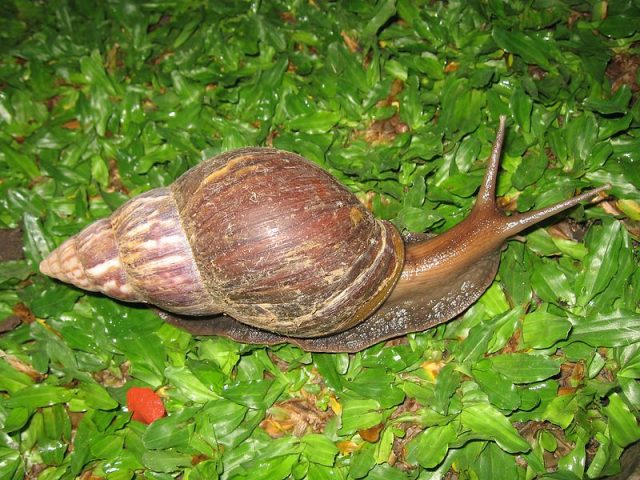Type the name of the breed you're looking for below
[wpdreams_ajaxsearchlite] Don't see the breed your're looking for? Click here and let us know!
Giant Land Snail
| Place of Origin and Range | Giant African land snail is the common name used to refer to two genera and three species within the family Achatinidae, a family of unusually large African terrestrial snails. This snail is native to East Africa, and can be traced back to Kenya and Tanzania. |
| Description | The shell has a conical shape, being about twice as high as it is broad. Either clockwise (dextral) or counter-clockwise (sinistral) directions can be observed in the coiling of the shell, although the right-handed (dextral) cone is the more common. Shell colouration is highly variable, and dependent on diet. Typically, brown is the predominant colour and the shell is banded. The shell is particularly tough and has the highest heavy metal content of any snail species. |
| Adult Size | Can grow up to 8 in (20 cm) |
| Accommodation | Never use a small plastic container. They need plenty of room to climb and move around. The smallest enclosure you should use for two small to medium snails is a 10 gallon aquarium. Housing multiple medium snails or two large snails can require an aquarium as large as 30 or 40 gallons. Snails are good escape artists, so the enclosure will need a secure lid. If your house is humid and warm, you can use a wire mesh lid with latches. However, if there is a chance that the dry air in your home will affect the humidity levels of the habitat, we recommend the use of a glass or Plexiglas lid. You could also use a wire mesh lid with most of the lid covered by plastic wrap.Though it is important to keep the enclosure warm, never place it on a windowsill or anywhere else that it will be in direct sunlight. This will raise the temperature dangerously high, and you run the risk of actually baking your snails.The Giant Snail can now be found in agricultural areas, coast-land, natural forest, planted forests, riparian zones, scrub and shrub-lands, urban areas, and wetlands. |
| Lifespan | Can live up to 10 years |
| Feeding / Diet | The Giant Land Snail is a herbivore; it eats a wide range of plant material, fruit, and vegetables. It will sometimes eat sand, very small stones, bones from carcasses and even concrete as calcium sources for its shell. In rare instances the snails will consume each other. In captivity, this species can be fed on a wide range of fruit and vegetables, plain unseasoned mince or boiled egg can be fed occasionally Cuttle Fish bone is commonly used as a calcium source for healthy shell growth. It requires about 18.28% of crude protein in its diet for optimal growth. |
| Breeding | Like other land snails, these have intriguing mating behaviour, including petting their heads and front parts against each other. Courtship can last up to half an hour, and the actual transfer of gametes can last for two hours. Transferred sperm can be stored within the body for up to two years. The number of eggs per clutch averages around 200. A snail may lay five to six clutches per year with a hatching viability of about 90%. Adult size is reached in about six months, after which growth slows, but does not cease until death. Life expectancy is commonly five or six years in captivity, but the snails can live for up to ten years. They are active at night and spend the day buried underground. |



